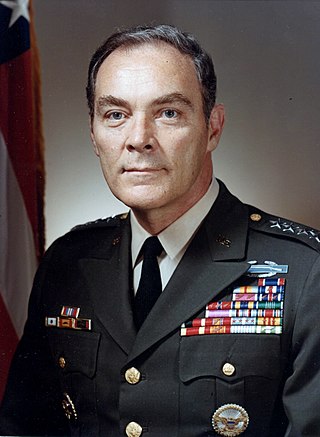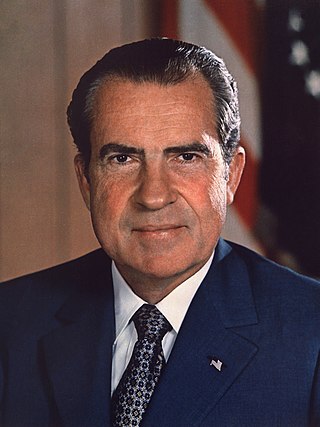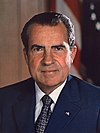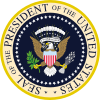
Henry Alfred Kissinger was an American diplomat and political scientist who served as the United States secretary of state from 1973 to 1977 and national security advisor from 1969 to 1975, in the presidential administrations of Richard Nixon and Gerald Ford.

Lê Đức Thọ, born Phan Đình Khải in Nam Dinh Province, was a Vietnamese revolutionary general, diplomat, and politician. He was the first Asian to be awarded the Nobel Peace Prize, jointly with United States Secretary of State Henry Kissinger in 1973, but refused the award.

Alexander Meigs Haig Jr. was United States secretary of state under president Ronald Reagan and White House chief of staff under presidents Richard Nixon and Gerald Ford. Prior to and in between these cabinet-level positions, he was a general in the U.S. Army, serving first as the vice chief of staff of the Army and then as Supreme Allied Commander Europe. In 1973, Haig became the youngest four-star general in the Army's history.

Melvin Robert Laird Jr. was an American politician, writer and statesman. He was a U.S. congressman from Wisconsin from 1953 to 1969 before serving as Secretary of Defense from 1969 to 1973 under President Richard Nixon. Laird was instrumental in forming the administration's policy of withdrawing U.S. soldiers from the Vietnam War; he coined the expression "Vietnamization," referring to the process of transferring more responsibility for combat to the South Vietnamese forces. First elected in 1952, Laird was the last living Representative elected to the 83rd Congress at the time of his death.

Vietnamization was a policy of the Richard Nixon administration to end U.S. involvement in the Vietnam War through a program to "expand, equip, and train South Vietnamese forces and assign to them an ever-increasing combat role, at the same time steadily reducing the number of U.S. combat troops". Brought on by the Viet Cong's Tet Offensive, the policy referred to U.S. combat troops specifically in the ground combat role, but did not reject combat by the U.S. Air Force, as well as the support to South Vietnam, consistent with the policies of U.S. foreign military assistance organizations. U.S. citizens' mistrust of their government that had begun after the offensive worsened with the release of news about U.S. soldiers massacring civilians at My Lai (1968), the invasion of Cambodia (1970), and the leaking of the Pentagon Papers (1971).

Operation Linebacker II, sometimes referred to as the Christmas bombings, was a strategic bombing campaign conducted by the United States against targets in North Vietnam from December 18 to December 29, 1972, during the Vietnam War. More than 20,000 tons of ordnance was dropped on military and industrial areas in Hanoi and Haiphong and at least 1,624 civilians were killed. The operation was the final major military operation carried out by the U.S. during the conflict, and the largest bombing campaign involving heavy bombers since World War II.

The Paris Peace Accords, officially the Agreement on Ending the War and Restoring Peace in Viet Nam, was a peace agreement signed on January 27, 1973, to establish peace in Vietnam and end the Vietnam War. The agreement was signed by the governments of the Democratic Republic of Vietnam ; the Republic of Vietnam ; the United States; and the Provisional Revolutionary Government of the Republic of South Vietnam (PRG), which represented South Vietnamese communists. US ground forces had begun to withdraw from Vietnam in 1969, and had suffered from deteriorating morale during the withdrawal. By the beginning of 1972 those that remained had very little involvement in combat. The last American infantry battalions withdrew in August 1972. Most air and naval forces, and most advisers, also were gone from South Vietnam by that time, though air and naval forces not based in South Vietnam were still playing a large role in the war. The Paris Agreement removed the remaining US forces. Direct U.S. military intervention was ended, and fighting between the three remaining powers temporarily stopped for less than a day. The agreement was not ratified by the U.S. Senate.

Operation Menu was a covert United States Strategic Air Command (SAC) tactical bombing campaign conducted in eastern Cambodia from 18 March 1969 to 26 May 1970 as part of both the Vietnam War and the Cambodian Civil War. The targets of these attacks were sanctuaries and base areas of the People's Army of Vietnam and forces of the Viet Cong (VC), which used them for resupply, training, and resting between campaigns across the border in the Republic of Vietnam. The impact of the bombing campaign on the Khmer Rouge guerrillas, the PAVN, and Cambodian civilians in the bombed areas is disputed by historians.

Richard Nixon's tenure as the 37th president of the United States began with his first inauguration on January 20, 1969, and ended when he resigned on August 9, 1974, in the face of almost certain impeachment and removal from office, the only U.S. president ever to do so. He was succeeded by Gerald Ford, whom he had appointed vice president after Spiro Agnew became embroiled in a separate corruption scandal and was forced to resign. Nixon, a prominent member of the Republican Party from California who previously served as vice president for two terms under president Dwight D. Eisenhower, took office following his narrow victory over Democrat incumbent vice president Hubert Humphrey and American Independent Party nominee George Wallace in the 1968 presidential election. Four years later, in the 1972 presidential election, he defeated Democrat nominee George McGovern, to win re-election in a landslide. Although he had built his reputation as a very active Republican campaigner, Nixon downplayed partisanship in his 1972 landslide re-election.

1973 in the Vietnam War began with a peace agreement, the Paris Peace Accords, signed by the United States and South Vietnam on one side of the Vietnam War and communist North Vietnam and the insurgent Viet Cong on the other. Although honored in some respects, the peace agreement was violated by both North and South Vietnam as the struggle for power and control of territory in South Vietnam continued. North Vietnam released all American prisoners of war and the United States completed its military withdrawal from South Vietnam.

Manuel "Manolo" Sanchez was a long-time valet to Richard Nixon, known for his unfailing loyalty and fierce devotion to the former United States president. Sanchez was born in Spain and immigrated to Cuba at a young age. There, he worked as a dishwasher and laborer before moving to the United States. He was employed by Richard Nixon from 1962 to about 1980. The famously reserved Nixon developed a close friendship with Sanchez and once described him as a member of his family.
The US foreign policy during the presidency of Richard Nixon (1969–1974) focused on reducing the dangers of the Cold War among the Soviet Union and China. President Richard Nixon's policy sought on détente with both nations, which were hostile to the U.S. and to each other in the wake of the Sino-Soviet split. He moved away from the traditional American policy of containment of communism, hoping each side would seek American favor. Nixon's 1972 visit to China ushered in a new era of U.S.-China relations and effectively removed China as a Cold War foe. The Nixon administration signed the Anti-Ballistic Missile Treaty with the Soviet Union and organized a conference that led to the signing of the Helsinki Accords after Nixon left office.
The following is a timeline of the presidency of Richard Nixon from his inauguration as the 37th president of the United States on January 20, 1969, to December 31, 1969.
The following is a timeline of the presidency of Lyndon B. Johnson from January 1, 1968, to January 20, 1969.

The following is a timeline of the presidency of Richard Nixon from January 1, 1970, to December 31, 1970.
The following is a timeline of the presidency of Richard Nixon from January 1, 1974, to August 9, 1974, when, in the face of almost certain impeachment and removal from office, he resigned the presidency.

American diplomat Henry Kissinger (1923–2023) played an important and controversial role in the Vietnam War. Starting out as a supporter, Kissinger came to see it as a drag on American power. In 1968, Kissinger leaked information about the status of the peace talks in Paris to the Nixon campaign and was rewarded with being appointed National Security Adviser under Richard Nixon. As National Security Adviser, Kissinger sought initially to find a way to end the war on American terms. During his tenure, Kissinger came to differ with Nixon as Kissinger was more in favor of seeking an end to war as expeditiously as possible with minimum damage to American prestige. In October 1972, Kissinger reached a draft agreement that Nixon at first rejected, leading to the Christmas bombings of December 1972. The agreement that Kissinger signed in January 1973—which led to the American withdrawal from Vietnam in March of that year—was very similar to the draft agreement rejected the previous year. As National Security Adviser and Secretary of State, Kissinger favored continued American support for South Vietnam right until the collapse of that state in April 1975, which Kissinger blamed Congress for.
Decent interval is a theory regarding the end of the Vietnam War which argues that from 1971 or 1972, the Nixon Administration abandoned the goal of preserving South Vietnam and instead aimed to save face by preserving a "decent interval" between withdrawal and South Vietnamese collapse. Therefore, Nixon could avoid becoming the first United States president to lose a war.

The presidential transition of Richard Nixon began when he won the 1968 United States presidential election, becoming the president-elect, and ended when Nixon was inaugurated on January 20, 1969. Nixon had become president-elect once the election results became clear on November 6, 1968, the day after the election. This was the first presidential transition to take place following the passage of the Presidential Transition Act of 1963.
The Joint Chiefs of Staff (JCS) Readiness Test was a secret test and alert of U.S. military forces staged by the U.S. Department of Defense. It began on October 12, 1969, and consisted of a variety of military moves around the world, including activities by U.S. air and naval forces from the continental U.S. to the North Atlantic and from the Middle East to the Western Pacific.
















